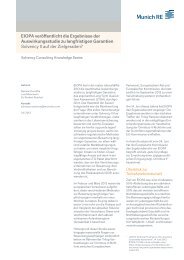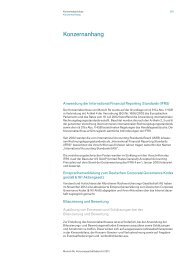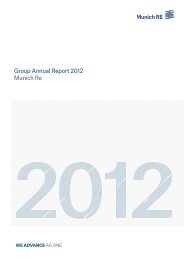Munich Re Group Annual Report 2006 (PDF, 1.8
Munich Re Group Annual Report 2006 (PDF, 1.8
Munich Re Group Annual Report 2006 (PDF, 1.8
You also want an ePaper? Increase the reach of your titles
YUMPU automatically turns print PDFs into web optimized ePapers that Google loves.
<strong>Munich</strong> <strong>Re</strong> <strong>Group</strong> <strong>Annual</strong> <strong>Re</strong>port <strong>2006</strong> Notes_Equity and liabilities<br />
Unearned premiums are accrued premiums already written for future<br />
risk periods. For primary insurance, these premiums are calculated<br />
separately for each insurance policy pro rata temporis; for reinsurance,<br />
nominal percentages are used in some cases where the data<br />
for a calculation pro rata temporis is not available. The posting of<br />
unearned premiums is restricted to short-term underwriting business,<br />
i.e. property-casualty and health business in both primary<br />
insurance and reinsurance.<br />
The provision for future policy benefits in long-term insurance<br />
business is posted for the actuarially calculated value of obligations<br />
arising from policyholders’ guaranteed entitlements. As well as life<br />
insurance, this concerns portions of health and personal accident<br />
insurance, insofar as the business is conducted like life insurance.<br />
Measurement is usually based on the prospective method, by determining<br />
the difference between the present values of future benefits<br />
and future premiums. The actuarial assumptions used for their calculation<br />
include, in particular, assumptions relating to mortality, disablement<br />
and morbidity, as well as assumptions regarding interestrate<br />
development, lapses and costs. These are estimated on a realistic<br />
basis at the time the insurance contracts are concluded and they<br />
include adequate provision for adverse deviation to make allowance<br />
for the risks of change, error and random fluctuations. The actuarial<br />
assumptions are adjusted if this is shown to be necessary by a liability<br />
adequacy test in accordance with IFRS 4.<br />
The measurement of the provisions for future policy benefits<br />
depends on the type of contract, being based either on FAS 60 (life<br />
primary insurance without performance-related participation in<br />
surplus, health primary insurance and the bulk of reinsurance), on<br />
FAS 97 (life primary insurance with limited premium payment, life<br />
primary insurance on the universal life model, unit-linked life insurance<br />
and life reinsurance for assumed policies based on FAS 97) or<br />
on FAS 120 (life primary insurance with performance-related participation<br />
in surplus).<br />
For contracts in accordance with FAS 60, the provision for future<br />
policy benefits is calculated from the present value of estimated<br />
future policy benefits (including claims adjustment expenses) less<br />
the present value of future net level premiums. Net level premium is<br />
that part of the gross premium that is needed to finance future policy<br />
benefits. Life primary insurance contracts with limited premium<br />
payment as per FAS 97 are generally valued in the same way as<br />
contracts falling under FAS 60. For all other contracts as per FAS 97,<br />
an account is kept to which net level premiums and interest earnings<br />
are credited and from which risk premiums and administration<br />
expenses are debited, not all credits and debits being contractually<br />
fixed at the time the contracts are concluded. The provision for future<br />
policy benefits for life primary insurance where policyholders bear<br />
the investment risk themselves (unit-linked life insurance) is shown<br />
separately under equity and liabilities item D. In the case of contracts<br />
162<br />
as per FAS 120, the provision for future policy benefits comprises the<br />
net level premium reserve and liabilities for terminal dividends. The<br />
net level premium reserve is calculated from the present value of<br />
guaranteed policy benefits (including acquired bonuses but excluding<br />
claims adjustment expenses) less the present value of future net<br />
level premiums. The net level premium is the net premium less the<br />
portion of the premium envisaged for covering claims adjustment<br />
expenses. The actuarial assumptions are generally the same as<br />
those used for premium calculation. The provisions for terminal dividends<br />
is built up proportionally with a fixed share of the expected<br />
gross profit margins. The same method is used for this as for determining<br />
the amortisation of the deferred acquisition costs.<br />
The provision for outstanding claims is for payment obligations<br />
arising from insurance contracts in primary insurance and reinsurance<br />
at the balance sheet date. Part of the provision is for known<br />
claims for which individually calculated provisions are posted.<br />
Another part is for expenses for claims whose occurrence are not yet<br />
known (e.g. because they have not been reported yet or have not yet<br />
manifested themselves). A third class of provisions covers claims<br />
which are known but whose extent has turned out to be greater than<br />
originally foreseen. All these provisions include expenses for internal<br />
and external loss adjustment expenses. The provision for outstanding<br />
claims is based on estimates: the actual payments may be higher<br />
or lower. The amounts posted are the realistically estimated future<br />
amounts to be paid; they are calculated on the basis of past experience<br />
and assumptions about future developments (e.g. social, economic<br />
or technological parameters). Future payment obligations are<br />
generally not discounted; exceptions are some provisions for occupational<br />
disability pensions and annuities in workers’ compensation<br />
and other lines of property-casualty business, which we discount.<br />
For determining the provision for outstanding claims, the <strong>Munich</strong> <strong>Re</strong><br />
<strong>Group</strong> uses a range of actuarial projection methods. They include<br />
the chain ladder method and the Bornhuetter-Ferguson method. In<br />
applying the statistical methods, we regard large exposures separately.<br />
The standard actuarial methods we use are applied both to the<br />
run-off triangles for the payments and to the run-off triangles for the<br />
reported claims, so that we obtain a range of estimates for the<br />
ultimate loss. Within this range, a realistic estimated value for the<br />
ultimate loss is determined for the balance sheet date. By deducting<br />
the payments already made, we arrive at the provision for outstanding<br />
claims recognised in balance sheet.<br />
Other technical provisions mainly include the provision for premium<br />
refunds in primary insurance and the provision for profit commission<br />
in reinsurance. Provisions for premium refunds are posted<br />
in life and health primary insurance for obligations involving policyholder<br />
bonuses and rebates that have not yet been irrevocably<br />
allocated to individual contracts at the balance sheet date. Where

















